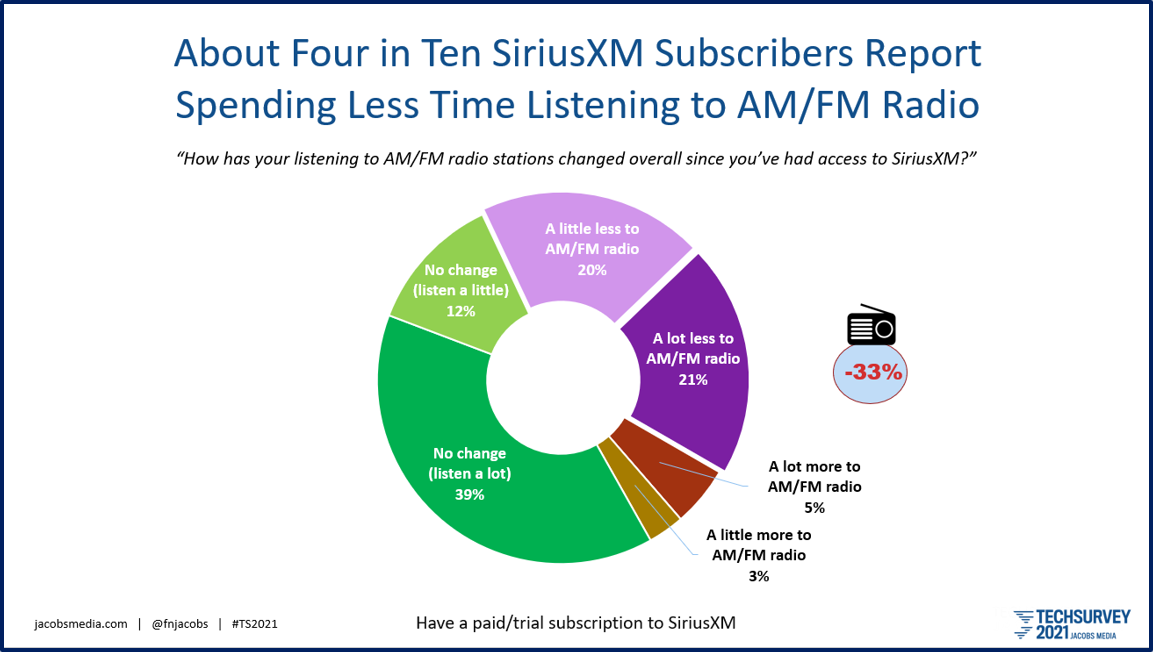RBR+TVBR OBSERVATION
As some three dozen lucky radio industry cognoscenti gathered in Las Vegas on January 6 to enjoy the 2022 Consumer Electronics and QR Code Showcase in Sin City, a veteran radio industry professional widely known for creating Classic Rock as an answer to hair-band free playlists fired off a fiery blog post that lambasted radio for shooting itself in the foot.
What was the problem? For the week ending January 2, 2022, Media Monitors’ Spot Ten Radio report showed Sirius XM accounting for some 33,794 spots aired across the AM and FM stations it tracks.
The latest Spot Ten Radio reports shows that it was likely a one-time deal, as the satellite radio company was absent from the top 10 for the week ending January 9.
Still, the presence of Sirius XM during that end-of-year week when subscription renewals are important is, in Fred Jacobs‘ view, a huge error in judgement, or perhaps a tremendous blunder.
We respectfully disagree and see no reason to panic and fret over radio advertisements designed to bring more attention to audio content. After all, it is Radio that allowed Sirius XM to even exist.
Jacobs’ blog post assails radio stations that have aired Sirius XM spots. Dumb, ill-thought decisions. Screwups. Embarrassments. Mistakes.
While those are one thing, Jacobs writes, “[T]here’s another whole class of bonehead moves. Those happen when we take out a gun and shoot ourselves in the foot.”
Yes, Radio. You’re on the hot seat, as Jacobs wants you to ask yourselves why you would “knowingly aid and abet a fierce competitor that is a stone cold threat – right now today?”
Um … you mean Netflix, Amazon, YouTube, Google, Facebook and Spotify?
No. He’s referring to Sirius XM, an offering that could only exist in a world where the radio industry’s own ostrich-like foibles could birth such a product — and let it thrive when it could have easily died 15 years ago.
“If you want to make a bombastic claim, make it on the medium where you’re going to have the greatest impact,” Jacobs says of the Sirius XM campaign.
This leads us to offer the first of six rebuttal points as to why Fred’s response to something any GSM would sign off on is rather short-sighted and perhaps outdated in 2022.
- RADIO DOESN’T ADVERTISE ITSELF
How can any industry leader slam Sirius XM for having the guts to advertise on AM/FM radio when the majority of radio stations haven’t spent meaningful dollars or resources on marketing or promoting their own properties? When was the last time you saw a television commercial for a radio station in your market — when Scott and Ross were doing the Free Money Birthday Game on the Z-Morning Zoo, or when those “Remarkable Mouth” rock station spots turned heads?
Aside from the all-in-the-family formulaic billboards slopped together for iHeartRadio stations appearing on Clear Channel Outdoor billboards, what sort of meaningful out-of-home advertising has Radio done in the last 20 years? Is there value in a Direct Mail campaign promoting a small-market radio station that could use a boost?
2. RADIO HELPED MAKE SIRIUS XM SUCCESSFUL
Sirius XM is consumed by perhaps 10% of U.S. consumers, with a percentage of those users on free trial plans. While the company is profitable, thanks to the 2008 merger of two independent cash cows burning through dollars, Radio shouldn’t be too concerned about Sirius XM stealing its listeners unless Radio allows them to do so. And, sadly, it is.
As this publication has stated before, DAB+ in the U.S. would have allowed Radio to build out its brands in a way that would have erased the need for satellite radio, unless hearing Howard Stern freely drop F-bombs is compelling enough to spend the money. In-band on-channel HD Radio is largely a failure. But, what if it wasn’t? What if radio companies invested in HD Radio and added five or six digital subchannels today to every radio station in a market they owned? First, the audio wouldn’t suck as much as Sirius XM’s tin-can 36kbps sonic horror show while cruising down the highway. Second, you’d put more value in a radio brand. Case in point: Z100 in New York.
As of today, Z100 has one HD multicast offering, something called Hit Nation Jr. — “Today’s Hits, Family Friendly.” What the hell is that? If iHeart had a clue, they’d put “The Flamethrower” on HD2, make it all ’80s based on Scott Shannon and Frankie Blue’s original handiwork, bring back all of the old jingles, and have Ross Brittain voicetrack. Then, the HD3 signal could be “Z100 Nineties,” embracing the mid-1990s era with Elvis Duran offering some voicetracked shifts, or perhaps Elliot Segal. Lastly, the HD4 channel could be “Z100’s 2k2Day” channel, with the hits from 2001-2019 in one place.
You don’t want to have advertisements from a service offering 80s on 8, 90s on 9, and decade-specific channels for the 2000s and 2010s, Radio? You’ve had two decades to do it yourself. You still can, with HD Radio, promoting its existence in a meaningful way, and using it in a marketing campaign that assails Sirius XM for being costly, and having lousy audio quality with respect to its in-dash receivers.
3. RADIO AND SIRIUSXM GO TOGETHER
Hmm … Audacy and iHeartMedia, along with other companies including Cumulus Media and Beasley Media Group, have gone gaga over podcasting. Yet, that’s taking ears away from AM and FM — horrors! So, what’s the BFD about Sirius XM? Oh … it’s an “alternative” that will lead listeners away from AM/FM.
Has anyone thought about the “why” behind this behavior? I present to you Washington, D.C. — arguably the most disappointing radio market in the U.S., unless you’re a Wonk, love great R&B radio, enjoy all-News, or like the entertainment value of the aforementioned Elliot and recently returned veteran air personality Don Geronimo.
Thirty years ago, one could enjoy Jazz on WDCU “Jazz 90.” Today that is C-SPAN Radio. Hello, Sirius XM radio. Thirty years ago, there were tons of rock choices, including DC101, WCXR, WJFK, WHFS and Baltimore’s 98 Rock and WGRX. It would be nearly two years before “Arrow 94.7” arrived. Today, the rock and roll variety is much, much smaller — leaving Sirius XM as the only real source of what once existed in 1992. Then, there’s the Hot Adult Contemporary sound, completely absent from Washington thanks to the demise of Mix 107.3, following the October 2018 end of “Fresh FM” at WIAD. Rimshot “92.5 WINC FM” is now a KLOVE Member station, as is the old Mix. Here again, Sirius XM is the only home in Washington for the fan of this format.
The build-out of HD Radio could have prevented these format voids, reducing the likelihood that in such an affluent market, the “SXM” button would be a more likely go-to than FM when wanting to hear music while stuck on Shirley Highway or the Capital Beltway.
The graphic below may be troublesome to some. For us, it is indicative of radio not doing enough to offer disenfranchised listeners an opportunity to stay with the medium.

4. SIRIUS XM ISN’T A BIG THREAT
Despite Fred Jacobs’ statement that Sirius XM is “a bigger threat to AM/FM radio than podcasts, Spotify, TikTok, YouTube, or Twitch,” we vociferously disagree.
Spotify, TikTok and YouTube are “threats,” and perhaps bigger than Sirius XM.
But, at the end of the day, it is all additive to the audio story. This is an opportunity for the radio industry’s C-Suite leaders to unite, and sell Radio’s story, instead of whining about a more savvy operation.
Speaking of TikTok … Sirius XM’s Channel 4 is TikTok Radio, for Christ’s sake. Where the heck was radio on this??
5. RADIO ISN’T TECH SAVVY
Uh-oh. Here comes the hate mail. But, let’s just ask this question: How many radio broadcasting companies have a R&D operation in Silicon Valley?
What is Radio’s presence in the heart of America’s tech hubs?
What Radio companies presented at CES 2022, instead of being present?
6. SLAY THE DEADLY STOP SET
We asked the wife of our editor-in-chief why she chooses to consume Sirius XM nearly exclusively, aside from asking the Alexa device at home to tune to a couple of broadcast radio stations of preference.
The first thing she said, “There’s not a lot of commercials and less breaks. Who would want to have 20 minutes of an hourlong commute to work full of commercials?”
There you have it. While “multiple options depending on one’s mood” and “accessibility, with Sirius XM available everywhere” (despite the proliferation of iHeartRadio, Audacy and TuneIn apps) were also big reasons why Sirius XM won over Radio, the very long commercial breaks, oftentimes piggybacking on sponsored traffic and/or weather segments and station owner promotional messages are killing AM and FM. Period.
You don’t want to accept advertising from Sirius XM? It’s high time radio rethink how it handles is advertising solutions.
We love radio. In fact, we enjoyed listening to WSPK “K104.7” in Poughkeepsie, N.Y., and WDST “Radio Woodstock” in Woodstock, N.Y., this morning — terrific live and local properties with just the right blend of music, personality and commercials. The latter station has a strong online presence, and streaming on iHeartRadio. But, these examples are overshadowed by the more high-profile clutter-filled stations that, despite their strong ratings performances, are still leaders in an ever-shrinking sea of ears.
If Sirius XM commercials shouldn’t be on the radio, Radio needs to take steps to erase the reasons one would go there.
Sadly, it has failed to do so and likely won’t solve that problem anytime soon.
The views expressed in a RBR+TVBR Observation are those of the editorial staff of the Radio + Television Business Report and not reflective of Streamline Publishing management or the editorial leadership of Radio Ink and Podcast Business Journal.
TALK BACK TO RBR+TVBR! We’d love to know what you think. Please offer your comments below or send an email to [email protected].





